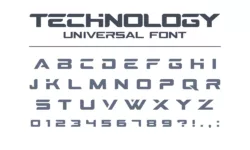One thing in the world of design and art that is both freeing and frustrating is that there are a few rules, and even a few best practices, but not many of them are truly set in stone. You can bend some rules, and in the right context even break them. So, how do you go about figuring out effective font combinations? Knowing some guidelines helps, as you can start with what’s already known to work well so you can expand your comfort zone past the basics should your design need it.
1) Pick Complementary Fonts
A lot of fonts have their own personality or mood. They might be elegant, playful, casual, or serious. You should be certain that the moods your font choices have are in alignment with the intended purpose of your design. For example, rounded and bubbly typefaces might be more appropriate for a party invitation to a kid’s birthday, but not so much for a professional newsletter.
As often happens with people, opposites might attract. You might find an ‘extroverted’ font and an ‘introverted’ font that combine nicely. Likewise, you might find a distinct font you like that has ‘strong personality.’ It can make a good display font, but only if it gets paired with something more conservative or neutral to make for a good balance. A larger font with hand-painted and curvy appearance is going to have quite a bit of personality, so it could be effectively set off from a simpler san-serif in all caps, which wouldn’t prove distracting from a primary font, but can still be legible in its smaller sizing.
Choosing two, three, or even more fonts that complement one another is like guessing. You have to trust your own judgment, going with your gut and instinct, and that’s fine. It’s also good to start looking out for various fonts being combined out in the world. Look for font pairings anywhere from product packaging and roadside signs to magazines and websites to develop your eye for what actually works, and what does not.
2) Create A Visual Hierarchy
Magazines and newspapers are among the many traditional publishing formats that illustrate good ways of the application of a visual font hierarchy. They combine different fonts in ways that separate various text elements like captions, body copy, headlines, and sub-headlines or bylines from each other. They can control how human or reader eyes navigate a page and establish which pieces of text get attention first by deliberate influencing qualities such as boldness/weight, size, and spacing. Spacing alone can mean the leading, or the space between different lines, and kerning, which is the space between letters.
Hierarchy can get established for all design types, and not just for a layout that has a title and some body copy. When you are choosing fonts for your project, just consider which parts you would like viewers to put their attention on first.
Consider another way of looking at it: Choose just what information is crucial that needs to stand out on a first glance, such as a business name, a special offer, or a headline, and then figure out what it is less essential. Make your arrangement, size, and style font choice in accordance with these priorities. As a general rule of thumb, your most critical text element is the one you make the biggest and weightiest.
3) Context Is Always A Consideration
Where your design is going to appear is something that hopefully helps you figure out what particular fonts are good for the project which you’re working on. Text needs to be read easily in the sizes in which it gets displayed, and clarity is particularly crucial for small types. It’s sometimes wise to put small text into all caps with generous spacing to enhance legibility.
On top of size, the style of a font can also impact its readability. Not sure where to start in terms of choosing fonts within the design context? Look to match up a typeface’s perceived traits with any attributes that your intended message should have.
Port of this process is choosing what’s most appropriate to your project: display typefaces, neutral fonts, or a combination of both. In some circumstances, you’ll go for something that truly pops, and in other times, your context is going to require fonts that aren’t that distracting, like a long passage of text.
Context is also something you can approach at an angle of historical periods or even genre. Do some research into the actual background of any font you’re considering. Look up and learn when they got created, how they were created, and why. What purpose did their initial creation serve? You might even look for cultural contexts, as facts and information like this can indicate if their good design choices for your projects. For instance, if you’re trying to design a book cover for an Abraham Lincoln biography, then you might want to feature something like a stately serif font that actually saw use in the Civil War era, like Clarendon or Caslon.
Another example might be how particular font styles can play a critical role in solidifying the comprehensive look of a design, particularly if you’re aiming for a specific aesthetic. If you’re looking for a retro or 1950s theme, choose fonts that would have been used in period signage and advertisements.
4) Mix Up A Sans Serif With A Serif
Are you on a quickly approaching deadline and need to choose two fonts, pronto? Pick a sans serif and a serif. They usually work well together, especially if you use contrasting sizes.
It should be noted that there is ongoing debate across the typographical world if serif trumps sans-serif for readability, or vice-versa. In larger volumes of text, serif fonts are typically assumed to help the human eye move along efficiently, boosting reading speed, particularly in print, although specific characteristics of the actual font in use matter a lot. Alternatively, sans-serif fonts are usually favored for on-screen, online, and digital text given the fact that the simplified letterforms often display a lot more clearly in a number of screen resolutions.
5) Establish Some Contrast
One of the primary reasons that pairing up serif fonts with sans-serif fonts often works well is due to the contrast that is established. Contrast is something that can bring multiple concepts together in a fusion that allows for fonts to complement one another and have hierarchy.
You can achieve contrast in any number of ways, including color, spacing, weight, size, and style, among many others. A tall, thin font might actually complement a bold, chunky font, because even though they might be total opposites, the differences between them work out really well, or a plain font can look great contrasted with one of these script fonts. The contrast creates a very distinct role for both of the fonts, letting each of them pop as an individual piece of information. Play around with sizing, perhaps using larger sizes for skinny fonts so they don’t get lost against backgrounds or bolder fonts around them.
6) Stay Away From Conflict
When you combine fonts, you want contrast, but you want it without conflict. Just because specific fonts might be different, it doesn’t automatically mean that they’re going to work together very well. In general, typefaces which share a handful of qualities, perhaps lowercase letters with identical x-heights or similar proportions, have a higher chance of looking harmonious when paired together, even when their overall appearance has differences.
You might think that a sans-serif font and a serif font would work well together, but they don’t always. One might have well-spaced letters that are very rounded, and the other might have letters that are taller and more condensed. Add to this the contradictions between thicker, uniform structures and razor-thin letters, and you can see that they don’t work out that well together, even if the font names or family have close relations.
7) Don’t Pair Up Fonts Which Are Too Identical Or Similar
This is a flip side of #5. If you choose two fonts that have too much in common, it can be problematic because you have issues like not having enough contrast. The establishment of a hierarchy is hard to do, possibly even impossible, since your fonts aren’t really distinguishable from one another visually. Also, any discernible differences might look more like mistakes than intentional choices or purposeful decisions.
However, fonts do not need to be exactly like one another in order to be incompatible. Typefaces which are somewhat different but with comparable letter shapes, proportions, and/or weights might be similar to one another enough to fill your design with indistinct and even confusing appearances. This is especially true if they’re both used at equal sizes. A good thing to do is putting two fonts you want to use side by side in your design program, and then sit back for a moment, squinting. If both fonts look largely the same, then it’s a strong sign that your designs will benefit from the additional contrast between the types your choosing and using.








